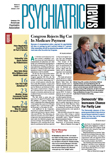The “tipping point” for adoption of electronic health records (EHR) by the nation's doctors and hospitals is likely to occur in seven years.
So said psychiatrist Robert Kolodner, M.D., the new interim coordinator for the federal Office of the National Coordinator for Health Information Technology, in an interview with Psychiatric News.
Kolodner said that while significant challenges remain, slow but steady progress is being made toward the vision of an “interoperative” national health information network linking doctors and hospitals. That vision was first elucidated when President Bush appointed Kolodner's predecessor, David Brailer, M.D., in 2004 and charged him with achieving widespread adoption of EHR within 10 years.
He told Psychiatric News that he believes that by 2014, the adoption of health information technology will reach a critical mass.
“Absolutely, we expect there to be substantial adoption within that timeframe,” Kolodner said. “I think today we are laying the foundation for future growth.”
Kolodner said that adoption of health information technology by the medical community follows a pattern seen in other industries: an initial phase when early risk-taking adopters help to work through problems with the technology, followed by a phase of more rapid adoption as evidence of the benefits of a technology become known.
That phase is followed by a period of very rapid adoption when the popularity of the new technology reaches a critical mass, such as was seen with the adoption of fax machines and later the Internet.
“Electronic health records are more complex and challenging, but health care is following the same adoption curve,” Kolodner said.
Kolodner became interim national coordinator on September 20, 2006, after Brailer stepped down. Kolodner was previously with the Veterans Health Administration in the Department of Veterans Affairs (VA), where he was the chief health informatics officer and had been involved with the development and oversight of the VA's electronic health records system.
He received his medical degree from Yale University School of Medicine and completed a clinical fellowship in medicine at Harvard University School of Medicine and his psychiatric residency at Washington University School of Medicine.
In the interview with Psychiatric News, Kolodner referenced a report by the Robert Wood Johnson Foundation showing that, depending on criteria used to measure adoption, between 17 percent and 24 percent of physicians in ambulatory settings had access to some form of EHR in 2005; approximately 9 percent had access to specific functions such as computerized prescription ordering, computerized test ordering, electronic results, and electronic physician clinical notes.
“Those are the numbers we are using as our baseline in 2005 to represent systems that are actually in use,” Kolodner said.
Among the challenges in speeding the adoption of EHR, he said, is the fundamental one of making physicians and the public aware of the value and importance of an electronic health network. He cited the American Health Information Community, a federal advisory group charged with articulating the benefits of EHR and its impact on the quality of health care and on the economy.
Another major challenge is “harmonization” of electronic systems, a feat that is being accomplished through federal certification of those systems by the Certification Commission for Healthcare Information Technology (CCHIT). That process is designed to ensure that commercial electronic record systems have certain essential features in common, thus ensuring “interoperability”—the ability of systems to“ talk” to each other to allow seamless transfer of information across the electronic health care landscape.
Kolodner said some 35 products had been certified by CCHIT.
Still another challenge is facilitating adoption of EHR by small-group and solo physicians. “Right now small-group providers have an adoption rate about half the rate of the larger providers,” Kolodner said. “We know that is a group we have to pay attention to.”
He cited recent federal rules creating new exceptions and “safe harbors” to existing federal fraud and abuse laws governing the provision of electronic health information technology and services by health plans and other entities to physicians and hospitals for handling EHR and electronic prescribing.
Because of the cost to small group and solo physicians of purchasing electronic systems, some health plans and other entities may offer physicians hardware and software for electronic prescribing as well as reimbursement for first-year subscription fees. Such transactions could be interpreted as violating federal laws, hence the importance of the new rules providing exceptions and safe harbors (Psychiatric News, September 1, 2006).
Kolodner acknowledged the significant concerns psychiatrists and other physicians have about confidentiality of records. “Privacy and confidentiality are fundamental to our being able to move forward,” he said.
He emphasized that he believes the adoption of EHR will reap enormous benefits for patients with psychiatric illness.
“The President's New Freedom Commission noted that health care for behavioral illness is very fragmented,” he said. “The real danger is not that information is getting out, but that the right information isn't getting to the clinicians who need it. It's important for us to make sure the appropriate information is available to us so we can provide the best quality care, and that our information is available to other clinicians so our patients do not get second-class care, but are on par with patients with other types of health conditions.”
The Robert Wood Johnson report, “Health Information Technology in the United States: the Information Base for Progress,” is posted at<www.rwjf.org/files/publications/other/EHRReport0609.pdf>. The Web site for the the Commission for Healthcare Information Technology can be accessed at<www.cchit.org/>.▪

